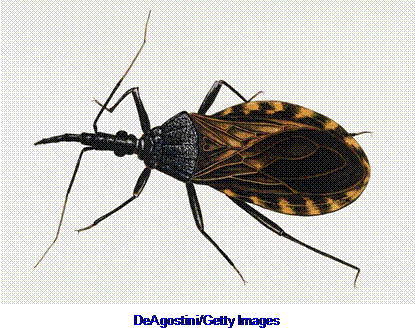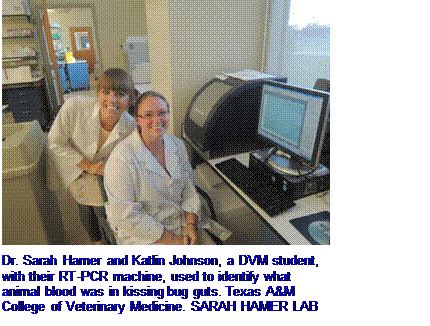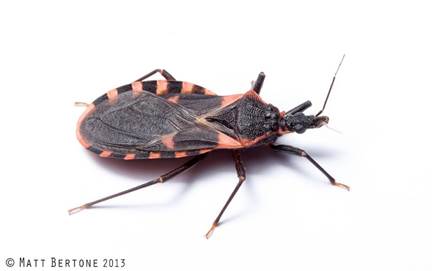
Authored by Gwen Pearson. This article was first appeared on WIRED, 12.03.15.
CHILL. KISSING BUGS ARE not invading North America. They’ve been here for at least 12,000 years, probably longer. The link between Chagas disease and kissing bugs (Triatoma) is real, and Chagas disease is a serious, untreatable disease you do not want to acquire. But nothing other than a recent burst of media attention is, well, news.
 I talked to Dr. Sue Montgomery, leader of the epidemiology team in the CDC Parasitic Diseases
I talked to Dr. Sue Montgomery, leader of the epidemiology team in the CDC Parasitic Diseases
Branch, as well as some key US researchers on Chagas disease. I also checked with several Insect Diagnostic Clinics around the US. Everyone agreed: There is no evidence that new infections of Chagas are increasing in the US, or that the insects that transmit the disease have increased or changed their range. The disease itself is extremely rare; fewer than 40 human infections have occurred in the US since 1955.
They also shared that they had been inundated by public inquiries over the last week, driven by media coverage. And Americans are terrible at identifying actual kissing bugs.
Dr. Sarah Hamer is a researcher that specializes in disease eco-epidemiology, or diseases found in wildlife that occasionally cross over to humans. “Our lab has received around 800 emails/photo inquiries about potential kissing bug encounters in the last two weeks, but less than two dozen were actual kissing bugs,” she says. Far north of where these insects actually occur, Canadian and Iowan entomologists reported they had received inquiries as well.
 This isn’t the first time there’s been a bit of a media kerfuffle about these bugs. In 1899 there was a “kissing bug epidemic.” In the words of the Chief of the Bureau of Entomology at the time, L.O. Howard: “By ‘epidemic’ is meant the newspaper epidemic, for every insect bite where the biter was not at once recognized was attributed to the popular and somewhat mysterious creature which had been given such an attractive name.”
This isn’t the first time there’s been a bit of a media kerfuffle about these bugs. In 1899 there was a “kissing bug epidemic.” In the words of the Chief of the Bureau of Entomology at the time, L.O. Howard: “By ‘epidemic’ is meant the newspaper epidemic, for every insect bite where the biter was not at once recognized was attributed to the popular and somewhat mysterious creature which had been given such an attractive name.”
What does the average person in North
America really need to know about Chagas Disease? And why are there periodic freakouts about it?
How Do You Get Chagas Disease?
It’s reasonable to feel a little worried about kissing bugs: They transmit Chagas, a chronic heart disease caused by the blood parasite Trypanosoma cruzi. But if you are reading this on your smart phone, you probably are not part of the population at risk. Chagas infection is strongly linked with poverty, and kissing bugs are mostly found in homes with dirt floors and in poor repair. If you are a camper or hunter, then you might need to think about controlling your exposure to these bugs, if you live in a region of the country where the insects occur.
“Some of [these bugs] do carry the parasite, but they’re much more interested in feeding on wild animals than on people,” says Montgomery. “They live out in the woods. They’re not trying to get into people’s homes. They’re not preferentially feeding on people.”
If you manage to be bitten by one of these bugs, and if a very specific set of circumstances occur, odds are you still won’t be infected. Research suggests that it can take more than 900 bites for transmission to occur.
 Kissing bugs are a relative of bed bugs, and they both feed the same way—they stick a beaky straw into your skin and slurp up your blood. But it’s not the bite that transmits the disease. Kissing bugs poop after they feed, and if the bug is infected, its poop contains the parasite. When you scratch the itchy bite, there is a chance you will rub the bug feces into the wound. Unless you get poop from an infected bug under your skin, you won’t get infected with Chagas.
Kissing bugs are a relative of bed bugs, and they both feed the same way—they stick a beaky straw into your skin and slurp up your blood. But it’s not the bite that transmits the disease. Kissing bugs poop after they feed, and if the bug is infected, its poop contains the parasite. When you scratch the itchy bite, there is a chance you will rub the bug feces into the wound. Unless you get poop from an infected bug under your skin, you won’t get infected with Chagas.
Are You At Risk in the US?
There are at least 11 native species of kissing bugs in the Americas, and most are capable of transmitting Chagas. There are a few ways that you can get Chagas disease without being bitten by a bug - blood transfusion is one of them. (Eating kissing bugs is another, but I suspect that isn’t on your dietary to-do list.)
Dr. Melissa Nolan Garcia, Baylor College of Medicine, researches human Chagas disease.
“With the onset of blood donor screening in 2007, we now have a form of active surveillance through the blood bank. That’s probably why we’re catching more cases now.” Says
Montgomery: “There haven’t been any cases of transfusion-transmitted Chagas disease since the introduction of blood donor screening, so the system seems to be working.”
Hamer agrees. “Kissing bugs prefer to live and feed in wooded or brush areas,” she says. “It is much more common for US wildlife to be infected with the parasite: raccoons, wood rats, opossums, etc.” Hamer’s lab is trying to figure out just where kissing bugs live, and what they eat regularly. Coyotes, feral pigs, and a whole host of other mammals are infected with the Chagas parasite, including dogs.
“We’ve got better tools now, so we are able to look for and find this infection more. But a build up of infected wildlife wouldn’t necessarily create a proportional build up of human disease risk, just because it wouldn’t change the way that most humans would be infected,” said Hamer.
Dogs can be infected with Chagas, and research in Hamer’s lab found that about 10 percent of dogs in Texas animal shelters have antibodies to the disease. But, that means they have been exposed - not that they are contagious or carriers of the disease.
Chagas is not transmitted by sexual contact between infected people, or by contact with infected non-human mammals, despite some reports calling it “the new AIDS.” Kissing bugs are not poisonous either.
Garcia advised that hunters might want to wear gloves to prevent the possibility of getting blood from infected animals into a cut, although that is precautionary.
That Bug You Saw Is Probably Not Going To Kiss You
Most states have Insect Diagnostic Clinics. That’s not where you take ailing bugs, it’s where you send samples to find out what is eating your soybeans or tomatoes. In the last two weeks, some of the clinicians I talked to have reported an uptick in submissions of bugs with concerns that they are kissing bugs. Learning to identify kissing bugs correctly is clearly an issue.
Rachel Curtis-Robles is a doctoral student in Hamer’s research group, and runs a citizen science project to collect and analyze kissing bug gut contents from the Southwest US. She told me “the Citizen Science Project is a great way to get bugs from a lot of places that we wouldn’t be able to go and get bugs by ourselves, because kissing bugs are pretty elusive.” Hamer added “Each bug is so valuable because we can use DNA from the gut from one thing, and DNA from its legs for another question.”
Less than 1 percent of their recent inquiries about kissing bugs were actual kissing bugs. Or even bugs at all. There are several handy guides to Things That Are Not Kissing Bugs online.
If you want to have an insect of concern identified, try searching for your state’s name + “insect diagnostic clinic.” Each state has an Agricultural Extension unit that works to identify potential pest insects and plant diseases (although their services may not be free, they are usually low cost.) How rare is it that Kissing bugs are found in homes? Dr. Matt Bertone, of the North Carolina State University Plant Disease and Insect Clinic, dug into his archives for me. Since 1966, North Carolina’s had seven actual kissing bugs submitted. All the rest were some other sort of insects.
If you have clearly been bitten by something that appears to be a kissing bug, and there is blood involved, both Montgomery and Hamer said to contact your local Health Department. The CDC is not interested in your insects, despite news reports to the contrary. “Having people send samples of any kind to the CDC is just not how the system works. We don’t have a program for submission of insects from the public,” said Montgomery.
Immigration is not a factor
While here in the US Chagas is quite rare, that isn’t the case elsewhere in Central and South America. Efforts by the World Health Organization and others are yielding slow progress; in particular cases of congenital transmission between mother and child have been reduced. It’s children under 5 that are most infected in those regions.
People who test positive for Chagas in the US usually spent large amounts of time in Central and South America, whether because of travel or immigration. The US blood supply is monitored, and kissing bugs are not biting and transmitting the parasite between humans. Everyone I spoke to emphasized that greater knowledge by health care workers would help provide earlier and better care to those that had been exposed.
What Can You Do To Avoid These Bugs?
Garcia et al. 2014. Trypanosoma cruzi screening in Texas blood donors, 2008–2012. Epidemiology and Infection. DOI: 10.1017/S0950268814002234
Tenney et al. 2014. Shelter dogs as sentinels for widespread Trypanosoma cruzi transmission across Texas. Emerging Infectious Diseases 20(8).
Garcia et al. 2015. Development of Chagas Cardiac Manifestations Among Texas Blood
Donors. American Journal of Cardiology. DOI: http://dx.doi.org/10.1016/j.amjcard.2014.09.050
Garcia et al. 2015. Historical Perspectives on the Epidemiology of Human Chagas Disease in
Texas and Recommendations for Enhanced Understanding of Clinical Chagas Disease in the Southern United States. PLOS DOI: 10.1371/journal.pntd.0003981
Texas Citizen Science Kissing Bug Project
Chagas disease in Latin America: an epidemiological update based on 2010 estimates. WHO
Weekly Epidemiological Record No. 6, 2015, 90, 33–44